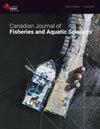鱼类年龄估计的未来:深度机器学习与耳石的傅立叶变换近红外光谱相结合
IF 2.2
2区 农林科学
Q2 FISHERIES
Canadian Journal of Fisheries and Aquatic Sciences
Pub Date : 2023-07-04
DOI:10.1139/cjfas-2023-0045
引用次数: 1
摘要
我们的新方法是利用多模态卷积神经网络(MMCNN)对耳石的傅里叶变换近红外(FT-NIR)光谱进行定量分析,以预测鱼类的年龄。我们整合了与鱼类年龄相关的两种关键数据模式:近9000个狭鳕样本的FT-NIR光谱的整个波数范围以及相应的生物和地理空间数据。该模型自动提取信息丰富的光谱特征,并阐明与鱼类生长相关的隐藏结构关系,以提高年龄预测。与7000至4000 cm−1波数相关的吸光度对模式预测的影响最大,其次是鱼的长度、纬度、深度和温度。优化后的模型整体性能良好,训练数据集的R2为0.93,RMSE为0.83,测试数据集的R2为0.92,RMSE为0.91。MMCNN的年龄预测与基于显微镜的年龄预测相当,精度相同或略高。此外,该模型优于经典的耳石光谱偏最小二乘分析,并弥补了年龄较大的鱼的预测偏差。本文章由计算机程序翻译,如有差异,请以英文原文为准。
The future of fish age estimation: deep machine learning coupled with Fourier transform near-infrared spectroscopy of otoliths
Our novel approach for fish age prediction uses quantitative analysis of Fourier transform near-infrared (FT-NIR) spectra of otoliths by means of multimodal convolutional neural networks (MMCNN). We integrate two key data modalities that are related to fish ages: the entire range of wavenumbers of FT-NIR spectra and corresponding biological and geospatial data for nearly 9000 walleye pollock ( Gadus chalcogrammus) specimens. The proposed model extracts informative spectral features automatically and elucidates hidden structural relationships associated with fish growth to improve age predictions. Absorbance associated with 7000 to 4000 cm−1 wavenumbers had the highest influence on model predictions followed by fish length, latitude, depth, and temperature. The optimal model resulted in good overall performance with an R2 of 0.93 and RMSE of 0.83 for training data set and R2 of 0.92 and RMSE of 0.91 for test data set. MMCNN's age predictions were comparable to microscope-based ages yielding as good or slightly better precision. Moreover, the model outperformed classical partial least squares analysis of otolith spectra and remedied prediction bias at older ages of fish.
求助全文
通过发布文献求助,成功后即可免费获取论文全文。
去求助
来源期刊

Canadian Journal of Fisheries and Aquatic Sciences
农林科学-海洋与淡水生物学
CiteScore
4.60
自引率
12.50%
发文量
148
审稿时长
6-16 weeks
期刊介绍:
The Canadian Journal of Fisheries and Aquatic Sciences is the primary publishing vehicle for the multidisciplinary field of aquatic sciences. It publishes perspectives (syntheses, critiques, and re-evaluations), discussions (comments and replies), articles, and rapid communications, relating to current research on -omics, cells, organisms, populations, ecosystems, or processes that affect aquatic systems. The journal seeks to amplify, modify, question, or redirect accumulated knowledge in the field of fisheries and aquatic science.
 求助内容:
求助内容: 应助结果提醒方式:
应助结果提醒方式:


